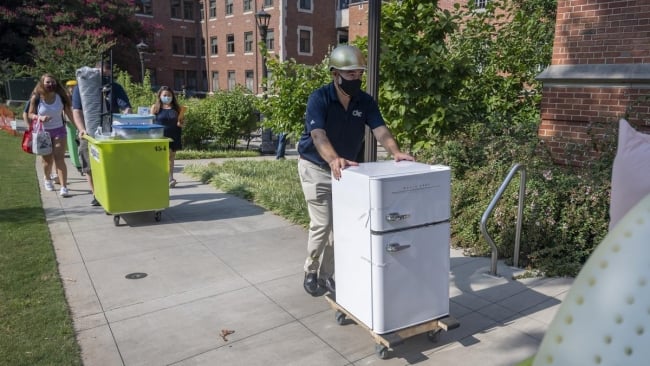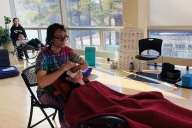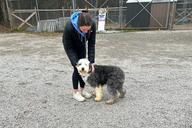You have /5 articles left.
Sign up for a free account or log in.

Georgia Tech President Ángel Cabrera pushed a refrigerator as first-year students moved into on-campus housing.
Christopher Moore, courtesy of Georgia Tech
In mid-July, Joshua S. Weitz presented a fall risk assessment to the Georgia Institute of Technology's Academic Restart Committee.
Weitz, a professor of biological sciences at Georgia Tech and founding director of the quantitative biosciences Ph.D. program there, recommended several strategies for mitigating COVID-19's spread: enforce mask-wearing requirements, test those on campus for the virus, reduce gathering sizes whenever possible and make online teaching the default until infection risks decline.
The ramifications of failing to mitigate the virus's spread were stark. Should campus reopen at full capacity and half of everyone on it be infected, Georgia Tech could expect about 75 fatalities. Approximately 10 students could be expected to die, along with 30 staff members, 25 or so faculty members and 10 or so affiliates -- such as contractors who aren't necessarily Georgia Tech employees but who have access to campus. Older faculty and staff members would suffer the most losses.
That scenario will not come to pass. It was based on what could be expected to happen if those on campus don't wear masks, if social distancing precautions aren't in place and if on-campus activities resume as normal. Georgia Tech has in fact put many of those mitigating strategies in place.
But the potential death toll is an important reminder of the high stakes as Georgia Tech brings students back to campus this week. Those stakes are at play at other universities across the state and country that are pursuing plans to resume in-person instruction this fall, as well as many that are backing away from once-ambitious return-to-campus plans. And that's not counting the health of locals who live near college campuses, even as college-town residents worry students returning to campus will spread infections throughout surrounding communities.
The point of the presentation was to reinforce why steps like mask compliance, COVID-19 testing and contact tracing are necessary, said Weitz, who was not on the Academic Restart Committee himself. He has nonetheless emerged as a strong public voice saying Georgia colleges are not ready to open and return 330,000 students to campuses, given current infection levels.
"It's important to provide a raw, unfiltered view of that scenario," Weitz said. "There is a need for direct evidence and realistic thinking, and we're not going to get out of this via magical thinking."
Knowing that the United States has logged more than 5 million COVID-19 infections and well over 160,000 deaths is one thing. Knowing what unchecked infections would look like on your campus is another.
"It's sometimes important to personalize and draw inferences at one's local scale," Weitz said. "I was trying to reinforce the critical need to take mitigation steps."
Such steps are particularly important in Georgia, which has seen COVID-19 cases and deaths spike, and where viral photos thrust the issue of infections and the reopening of K-12 schools into the national spotlight.
The question of mandating mask-wearing on public campuses in the state has been hotly contested.
Early this summer, the University System of Georgia said it strongly encouraged students and faculty to wear face coverings, pointing to state and federal guidance. It reversed course in July, requiring face masks to be worn on campuses after it was the target of petitioners. Georgia Tech faculty members also petitioned for a mask requirement.
As of Tuesday, Georgia Tech's campus guidelines website said faculty, staff, students and visitors must wear face coverings while inside of campus buildings "where six feet social distancing may not always be possible. Face covering use will be in addition to, and is not a substitute for, social distancing." Face coverings are not required in students' own residence hall rooms or suites, "when alone in an enclosed office or study room, or in campus outdoor settings where social distancing requirements are met."
Anyone not using a face covering will be asked to put one on, or leave. Those who don't comply will be disciplined.
A Georgia Tech website answering students' frequently asked questions says the university intends to "retain as much face-to-face interaction as possible." Classrooms were being reconfigured for social distancing, which included transferring some classes to larger spaces, outfitting classrooms with supplies of face coverings and, in some cases, providing plastic lectern barriers or face shields for lecturers.
The university is logging positive test results on a website. It reported two new cases Wednesday. One was a student living on campus who was being provided isolation housing. The other was a student who lives off campus and had been "notified as consistent with Georgia Department of Public Health."
Asked for comment, Blair Meeks, Georgia Tech's assistant vice president for external communications, provided a statement.
"Protecting the health and safety of the campus community is our priority with our return to campus plans," it said. "The plan draws from guidance provided by the University System of Georgia (USG), the governor's Covid-19 Task Force, the Georgia Department of Public Health (GDPH), the Centers for Disease Control and Prevention (CDC) and all existing executive orders from the governor of Georgia."
Epidemic Modeling's Limitations
Georgia Tech isn't the only university where researchers have used mathematical models to try to evaluate the spread of infections on campuses under different fall scenarios.
A study recently published in JAMA Network Open from Harvard and Yale researchers suggested screening students every two days with a low-sensitivity, high-specificity test and pairing it with good prevention practices in order to control outbreaks on campus. A working paper from Swarthmore College and University of Pennsylvania professors used modeling to evaluate effective mitigation strategies, finding in part that moving classes of more than 30 students online is one effective step.
Cornell University researchers earlier this year found that an in-person semester could actually result in fewer infections and hospitalizations for students and staff members than would an online semester, provided certain assumptions were met. Those assumptions included 9,000 students returning to Ithaca, N.Y., regardless of whether the university held in-person classes. A key driver there was that an in-person semester gives an institution the ability to test students for COVID-19.
But information about modeling the potential number of students on particular campuses who could become ill and die because of college administrators' decisions remains largely under the radar. Inside Higher Ed obtained Weitz's presentation as part of series of public information requests sent to several large public universities across the country seeking information about infection projections, fatality projections and reopening plans.
Weitz has not hidden his work. The potential death figures were included in documents he posted with another Georgia Tech professor on an open access research repository early this month. He's talked about the work in online videos.
Many universities evaluated models as they weighed fall reopening plans, and health experts discuss their work, experts say. But some also acknowledge reluctance to broadcasting their findings for the general public.
The models aren't forecasts, expert after expert reiterates. They're tools that can easily be misinterpreted.
"We can't reliably forecast three months into the future to be able to tell how many people will be infected on the campus," said Natasha Martin, associate professor of Medicine at the University of California, San Diego. "We're trying to use models to understand the relative benefit and impact of different risk-mitigation scenarios."
Still, the Georgia Tech situation demonstrates some of the different factors colleges, universities and their academic restart committees weighed as they considered fall plans. Such a window into decision-making is important at this point in time, when many higher education institutions are pulling the plug on previously announced plans to reopen to a large number of students this fall, citing the public health outlook -- even as others hold student move-in days.
Documents have also shown contractors pressuring universities in at least two states to think about financial considerations in reopening plans. That includes the University System of Georgia, which was pushed by Corvias, a provider of student housing services, to consider revenue impacts from limiting residence hall capacity. Universities have denied any outside influence, with many saying dorms are operating well below capacity and allowing for social distancing.
Risks and Recommendations for Georgia Tech
Weitz's presentation was organized as a slide deck dated July 13 and titled "Epidemic Assessment for Fall 2020: Risks, Mitigation Strategies, and Recommendations." It began by noting recent COVID-19 case numbers in the state.
"This is a critical phase of the epidemic," a second slide said. "A default mode of 'face-to-face learning' is not feasible, science should guide the decision-making process and policies at GT."
The presentation proceeded to examine the risk of classroom exposure using a COVID-19 event risk assessment planning tool. Assuming there were 10 times more COVID-19 cases than were being cataloged in testing, an event with 50 people in Georgia Tech's home county of Fulton County had an 84 percent chance of including at least one person with the virus, according to the document.
That tool is updated daily. Wednesday it showed an 88 percent chance under the same assumptions. Cut in half the assumptions about the number of cases not being cataloged in testing, and there would be a 65 percent chance that a Fulton County event with 50 people will include at least one person with the virus. Weitz cautioned that very little is known about the actual number of cases that aren't reported.
That doesn't reflect students coming to campus from out of the county, though. Weitz expects cases among students coming to campus.
"The challenge will be at the start of a term, most of the cases will be imported cases because the people were not here," Weitz said. "How do we stop the few from becoming the many?"
His presentation document goes on to detail the speed and size of outbreaks given different virus transmission rates. It suggests various mitigation strategies like mask wearing, testing with quick results, minimizing large group interactions and rapid contact tracing.
Then it lists potential mortality, assuming an unmitigated epidemic where 50 percent of campus is infected. The largest number of deaths could be expected among faculty and staff members between the ages of 60 and 69.
"Take-away: this scenario is based on an unmitigated epidemic; and highlights the need for action-taking," the document said with "unmitigated" underlined. It went on to point out that COVID-19 has many severe potential outcomes other than death, including lung damage and long-term health problems like damage to tissue function.
This is an important time for Georgia Tech and other campuses with students returning to think about the long-term health risks of an infection.
"We should have more understanding of what the risks are, precisely, so we can generate the public support necessary to get these interventions," Weitz said. "The reality is these things can move fast and there is significant asymptomatic spread and even the asymptomatic probability is higher in young people."
Georgia Tech officials expect thousands of returning students to begin arriving on campus today. About 2,600 first-year students already moved in over the weekend. The university is hosting virtual and in-person events for first-year students under the banner of a "Week of Welcome."
A Week of Welcome 2020 guide lists events including residence hall first floor meetings on Sunday and a virtual comedy show Monday. It includes tips for mask wearing and other recommendations to fight the spread of germs, including washing hands for 20 seconds and avoiding "close contact with sick people."
The guide includes a "Top 10" list of tips from the Georgia Tech Residence Hall association, including "Get moving" at the campus recreation center, "Get involved" in Greek life or other student organizations, and "Enjoy college."
"Make the most of it," the entry on enjoying college reads, "allow yourself to make mistakes, don't get too caught up in the negatives. Don't keep your eyes so focused on the prize that you forget to enjoy the journey that you're on."
A Sunday news release from Georgia Tech notes that first-year students experienced "no ordinary move-in experience." Students used smartphone apps to pick check-in times and were given keys to their rooms without ever leaving vehicles. Volunteers helped families, but never more than a "handful" of students moved into a building at once.
The release continued: "In each dorm, students found a wellness kit with hand sanitizer, a thermometer and a cloth face covering -- complete with the Georgia Tech logo, of course, to get their school spirit collection started."
-- Madeline St. Amour contributed reporting to this article.




